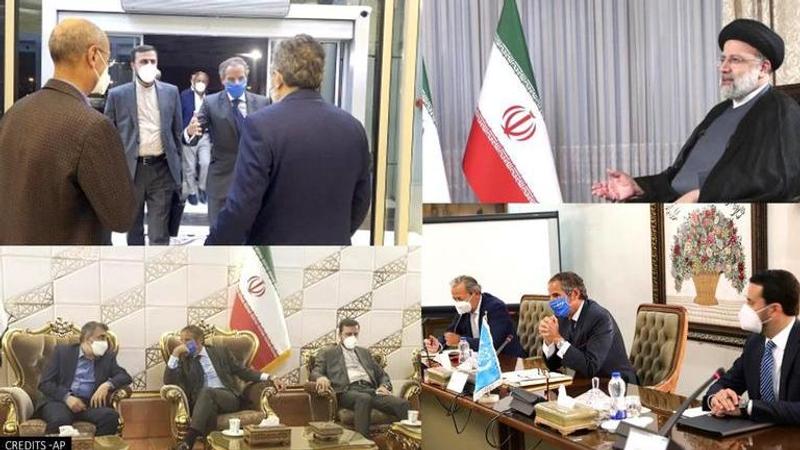Published 09:01 IST, September 13th 2021
Iran, IAEA reach agreement on servicing monitoring cameras to avert nuclear deal crisis
"We agreed over the replacement of the memory cards of the agency's cameras," Iran's AEOI head Eslami told an Iranian press conference.

Iran and the International Atomic Energy Agency (IAEA) on Sunday, Sept. 12 reached an agreement that would permit the United Nations to upkeep monitoring cameras at Iranian nuclear sites. In order to avert the deadlock in talks pertaining to the 2015 nuclear deal known as the Joint Comprehensive Plan of Action (JCPOA), Tehran and the UN nuclear watchdog agreed to reinstate the surveillance equipment at sensitive Iranian nuclear facilities.
The international inspectors will now be able to install new memory cards into surveillance cameras and resume the video recording in a new diplomatic step forward, although the deal still leaves Iran and the IAEA in the same spot as February 2021. And it remains unclear if the copies of the older recordings, which Iran threatened to destroy, will be handed over to the IAEA.
According to the Joint Statement by the Vice-President and the Head of Atomic Energy Organization of the Islamic Republic of Iran (AEOI), Mohammad Eslami and the Director-General of the IAEA, Rafael Grossi, the two parties “recalled and reaffirmed cooperation and mutual trust and emphasised on the necessity of addressing the relevant issues in a constructive atmosphere, and in a technical manner.” As per the talks held in Tehran between Grossi, and Eslami, “IAEA's inspectors are permitted to service the identified equipment and replace their storage media which will be kept under the joint IAEA and AEOI seals in the Islamic Republic of Iran.”
"We agreed over the replacement of the memory cards of the agency's cameras," Eslami told an Iranian press conference.
Meanwhile, Grossi said, “I am glad to say that today we're able to have a very constructive result, which has to do with the continuity of the operation of the agency’s equipment here.” He added, “It is indispensable for us to provide the necessary guarantee and information to the IAEA and to the world that everything is in order.”
[The director-general of the International Atomic Energy Agency, Rafael Grossi (right), speaks with the deputy head of the Atomic Energy Organization of Iran, Behrouz Kamalvandi, upon his arrival at Tehran Imam Khomeini International Airport. Credit: AP]
International inspectors' access to surveillance terminated by Tehran
As the dialogue on Iran, the nuclear deal remains stalled in Vienna, and the negotiations between Tehran and the P5+1 are underway, Iran currently holds all the recordings at its nuclear sites. While the latter had permitted the IAEA to record activity at some of its critical nuclear facilities, in May 2021, Iran’s parliament speaker had announced that the UN nuclear watchdog and the international inspectors can no longer access surveillance images of its nuclear sites. Parliament Speaker Mohammad Bagher Qalibaf told the Iranian state TV that the window of negotiation with the US and other Western powers had narrowed amid escalating tensions during the diplomatic effort in Vienna and that the IAEA will not have the right to access to nuclear site images from May 22.
IAEA “collects and analyses hundreds of thousands of images captured daily by its sophisticated surveillance cameras” in Tehran nuclear sites under “Additional Protocol” of the JCPOA. In 2017, the UN nuclear watchdog installed over “2,000 tamper-proof seals on nuclear material and equipment”. But Iran’s Parliament in December, last year, passed legislation in the parliament that would suspend UN inspections of its nuclear facilities if European signatories did not agree to lift banking sanctions by February 2021. The IAEA had then managed to strike a three-month deal in order to hold Iran from executing the threat of “deleting all surveillance images.”
Later, Tehran’s member of parliament Ali Reza Salimi had convened an open session of parliament to ensure Iran's civilian nuclear arm "erased" the images. “Order the head of the Atomic Energy Organisation to avoid delay,” Salimi, a cleric from the central city of Delijan, told the Iranian state TV. The “recorded images in the cameras should be eliminated,” he stressed.
'Deal is a stopgas,' says Grossi
As the UN's nuclear watchdog and Iran now reach another temporary agreement, IAEA Director Grossi told reporters at Vienna airport while returning from talks in Iran, that the deal is a “stopgap”, and the measure will allow time for diplomacy in 2015 JCPOA talks. "This cannot be a permanent solution," Grossi said. "If you ask me how many months, how many days, it's difficult for me to say. But I don't see this as a long-term prospect." Furthermore, he informed that the damaged or destroyed cameras will soon be replaced and the IAEA would not neglect Iran's weapon-grade Uranium enrichment issues.
"There was a major communication breakdown with Iran and a risk of “immediate loss of knowledge” that this deal resolved. We need to sit down with the new administration and get them to commit to an engagement," Grossi told the presser after his return.
Grossi travelled to Iran on Saturday for talks reportedly facilitated by Russia. He told the press conference that the surveillance cameras will go back up at Iranian nuclear sites "within a few days, very soon” and that the IAEA would be able to keep the information “needed to maintain continuity of knowledge" of Iran’s nuclear stockpiling.
Updated 09:01 IST, September 13th 2021





